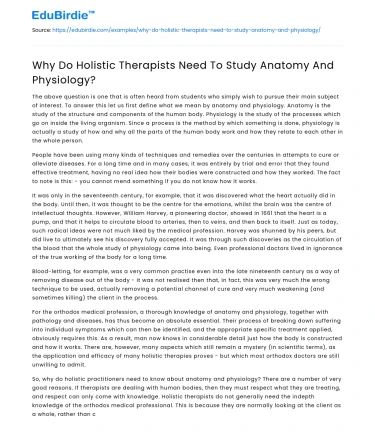The above question is one that is often heard from students who simply wish to pursue their main subject of interest. To answer this let us first define what we mean by anatomy and physiology. Anatomy is the study of the structure and components of the human body. Physiology is the study of the processes which go on inside the living organism. Since a process is the method by which something is done, physiology is actually a study of how and why all the parts of the human body work and how they relate to each other in the whole person.
People have been using many kinds of techniques and remedies over the centuries in attempts to cure or alleviate diseases. For a long time and in many cases, it was entirely by trial and error that they found effective treatment, having no real idea how their bodies were constructed and how they worked. The fact to note is this: - you cannot mend something if you do not know how it works.
Save your time!
We can take care of your essay
- Proper editing and formatting
- Free revision, title page, and bibliography
- Flexible prices and money-back guarantee
It was only in the seventeenth century, for example, that it was discovered what the heart actually did in the body. Until then, it was thought to be the centre for the emotions, whilst the brain was the centre of intellectual thoughts. However, William Harvey, a pioneering doctor, showed in 1661 that the heart is a pump, and that it helps to circulate blood to arteries, then to veins, and then back to itself. Just as today, such radical ideas were not much liked by the medical profession. Harvey was shunned by his peers, but did live to ultimately see his discovery fully accepted. It was through such discoveries as the circulation of the blood that the whole study of physiology came into being. Even professional doctors lived in ignorance of the true working of the body for a long time.
Blood-letting, for example, was a very common practise even into the late nineteenth century as a way of removing disease out of the body - it was not realised then that, in fact, this was very much the wrong technique to be used, actually removing a potential channel of cure and very much weakening (and sometimes killing) the client in the process.
For the orthodox medical profession, a thorough knowledge of anatomy and physiology, together with pathology and diseases, has thus become an absolute essential. Their process of breaking down suffering into individual symptoms which can then be identified, and the appropriate specific treatment applied, obviously requires this. As a result, man now knows in considerable detail just how the body is constructed and how it works. There are, however, many aspects which still remain a mystery (in scientific terms), as the application and efficacy of many holistic therapies proves - but which most orthodox doctors are still unwilling to admit.
So, why do holistic practitioners need to know about anatomy and physiology? There are a number of very good reasons. If therapists are dealing with human bodies, then they must respect what they are treating, and respect can only come with knowledge. Holistic therapists do not generally need the indepth knowledge of the orthodox medical professional. This is because they are normally looking at the client as a whole, rather than concentrating on specific symptoms.
Holistic therapists are looking to stimulate the body’s natural healing abilities however - rather than suppressing symptoms through the application of external inputs, such as man-made drugs. Some holistic therapists may perform this stimulation directly, by stimulating nerve endings or meridians, for example. Others may work by stimulating the client's natural healing energy. This is usually referred to as the vital force. The concept of vital force is a fundamental tenet of naturopathy. Holistic therapists need to know and understand what it is they are treating and, equally important, understand what the possible effects might be. In talking to the client, the information a holistic therapist receives is often directly related to various parts of the body and their (mal) functioning.
Inputs may well come from the client because of dissatisfaction with orthodox treatment. Medical information may be provided by the client arising from their previous interaction with doctors. In finding out what the holistic therapist needs to know about the client, and then analysing that in order to determine the best treatment, they must have at least a basic knowledge of the body’s anatomy and physiology so that they can understand what they are dealing with and therefore avoid doing something which might make the client's condition even worse. In some cases, this knowledge will not be required; in others, it can make a major difference in leading the therapist to an effective cure.
Another factor which cannot be ignored is that much of the criticism which the orthodox profession makes about holistic practitioners is that holistic practitioners do not know enough about the human body. Obviously from the orthodox medical professionals’ standpoint, and with the many years of training they have to undergo, this view is understandable and, in fact, it is not an unreasonable view.
The holistic therapist is trying to break down some of these barriers with orthodox medical practitioners so that more can be done together but, in order to do so, they have to be able to communicate effectively, which can generally only be done at present through the use of the proper medical terminology. Medical terminology requires a basic understanding of anatomy and physiology, together with an understanding of pathology and disease. So, the study of anatomy and physiology does very much have its place for holistic therapists. This Course should help you, the therapist, to readily obtain a good basic knowledge in a way which is both interesting and helpful.






 Stuck on your essay?
Stuck on your essay?

